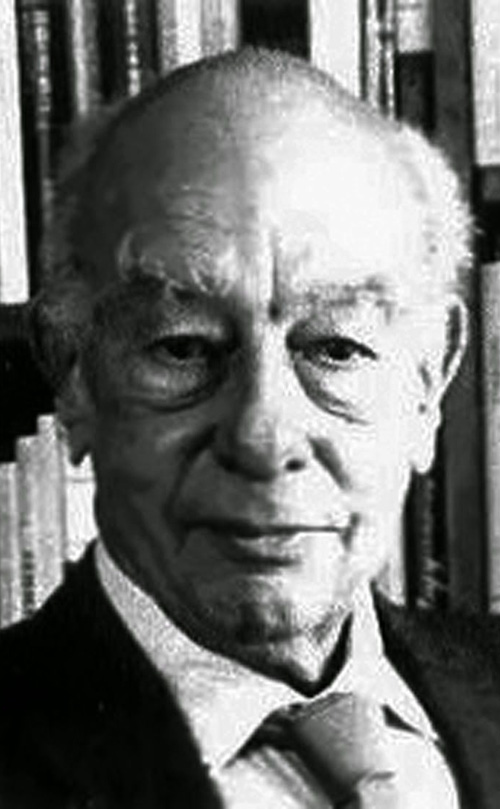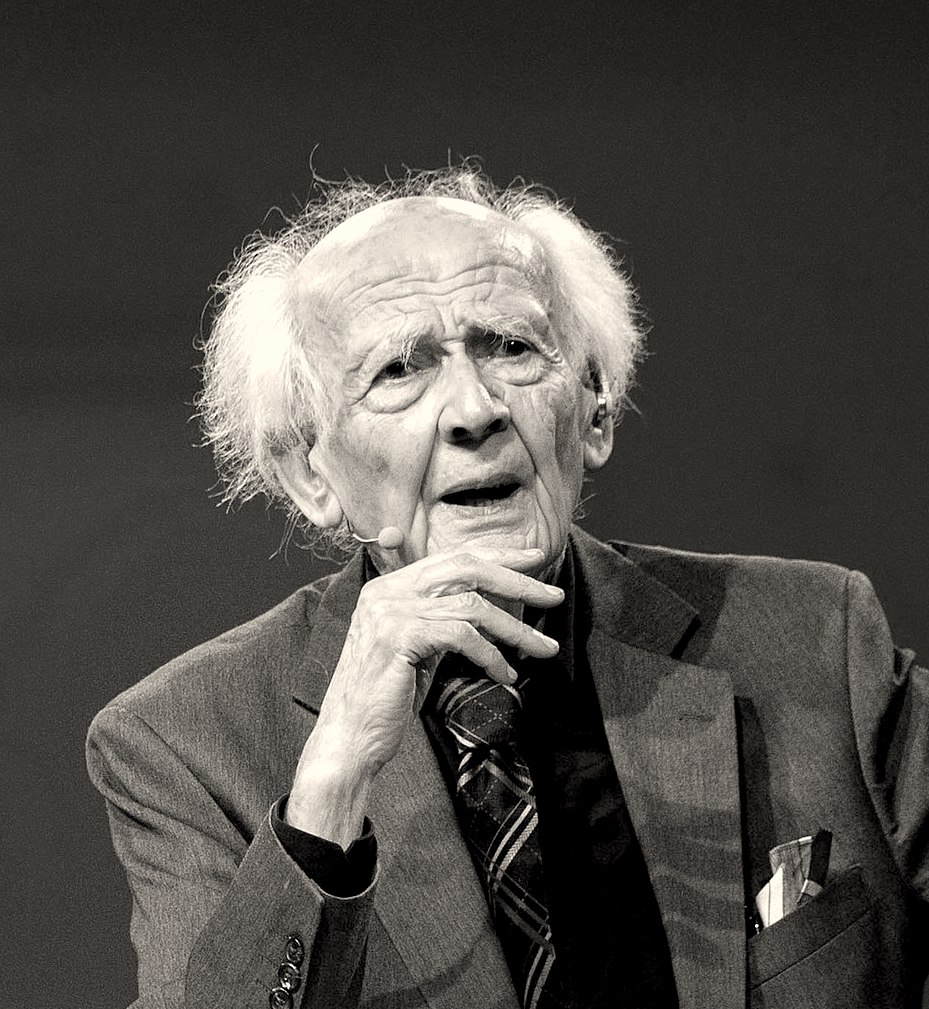Difference between revisions of "IMAGES"
m |
m |
||
| Line 41: | Line 41: | ||
<div class="col-md-7"><h3>Mirror ideogram</h3> | <div class="col-md-7"><h3>Mirror ideogram</h3> | ||
| − | <p>We use this metaphorical image, of the academic mirror, to point to the academic | + | <p>We use this metaphorical image, of the academic mirror, to point to the nature of the academic condition to which the insights reached in 20th century science and philosophy have brought us.</p> |
<p>Just as in Lewis Carrol's story from which this metaphor has been borrowed, the academic [[mirror|<em>mirror</em>]] is a trapdoor into a whole <em>new</em> academic reality.</p> | <p>Just as in Lewis Carrol's story from which this metaphor has been borrowed, the academic [[mirror|<em>mirror</em>]] is a trapdoor into a whole <em>new</em> academic reality.</p> | ||
<p> </p> | <p> </p> | ||
| Line 72: | Line 72: | ||
<h3>Seeing ourselves in the world</h3> | <h3>Seeing ourselves in the world</h3> | ||
| − | <p> | + | <p>So what <em>is</em> really the purpose of our (academic) pursuit of knowledge? </p> |
| − | <p> | + | <p>Or perhaps better said – <em>what should our purpose be</em>?</p> |
| − | + | <p>The space in front of the [[mirror|<em>mirror</em>]] is the space for academic self-reflection – in which the above and other similar questions are constructively considered.</p> | |
| − | <p>The space in front of the | + | <p>But seeing the world in the [[mirror|<em>mirror</em>]] and ourselves in that world has also another effect. The world we see is a world with an urgent need. Seeing ourselves in that world is bound to make us feel responsible.</p> |
| − | <p> | + | <p>And so we realize that this self-reflection – however interesting and necessary it might be – is not and cannot be an end in itself, but only a beginning.</p> |
| − | <p>And | ||
| − | |||
<h3>Stepping through the mirror</h3> | <h3>Stepping through the mirror</h3> | ||
| − | <p> | + | <p>This metaphorical act, of stepping through the [[mirror|<em>mirror</em>]], points to a surprising, nearly magical resolution to our quest for self-identity and purpose in front of the [[mirror|<em>mirror</em>]].</p> |
| + | <p>And as the case is in Lewis Carrol's story, by taking this step, we find ourselves in an academic reality that in many important ways looks like an inverse image of the reality we've grown accustomed to.</p> | ||
</div></div> | </div></div> | ||
<div class="row"> | <div class="row"> | ||
<div class="col-md-3"></div> | <div class="col-md-3"></div> | ||
<div class="col-md-6"> | <div class="col-md-6"> | ||
| − | <p>What makes this apparent | + | <p>What makes this apparent violation of physical laws academically possible is what Villard Van Orman Quine called [[truth by convention|<em>truth by convention</em>]]. |
<blockquote> | <blockquote> | ||
The less a science has advanced, the more its terminology tends to rest on an uncritical assumption of mutual understanding. With increase of rigor this basis is replaced piecemeal by the introduction of definitions. The interrelationships recruited for these definitions gain the status of analytic principles; what was once regarded as a theory about the world becomes reconstrued as a convention of language. Thus it is that some flow from the theoretical to the conventional is an adjunct of progress in the logical foundations of any science. | The less a science has advanced, the more its terminology tends to rest on an uncritical assumption of mutual understanding. With increase of rigor this basis is replaced piecemeal by the introduction of definitions. The interrelationships recruited for these definitions gain the status of analytic principles; what was once regarded as a theory about the world becomes reconstrued as a convention of language. Thus it is that some flow from the theoretical to the conventional is an adjunct of progress in the logical foundations of any science. | ||
| Line 95: | Line 94: | ||
<div class="row"> | <div class="row"> | ||
<div class="col-md-3"></div> | <div class="col-md-3"></div> | ||
| − | <div class="col-md-7"> | + | <div class="col-md-7"><h3>Truth becomes rigorous</p> |
<p>Truth by convention is the kind of truth that is common in mathematics: "Let <em>x</em> be... Then..." It is meaningless to ask whether <em>x</em> "really is" as stated.</p> | <p>Truth by convention is the kind of truth that is common in mathematics: "Let <em>x</em> be... Then..." It is meaningless to ask whether <em>x</em> "really is" as stated.</p> | ||
| − | <p>What makes | + | <p>What makes the magic academically possible is that the truth on the other side is (by convention) the truth by convention. We call this basic convention a [[methodology|<em>methodology</em>]]. </p> |
| − | |||
| − | |||
<p>It stands to reason that our foundation for creating truth and meaning must itself be as solid as possible.</p> | <p>It stands to reason that our foundation for creating truth and meaning must itself be as solid as possible.</p> | ||
<p>The foundations we've just outlined can be – and have been – made solid in three independent ways: | <p>The foundations we've just outlined can be – and have been – made solid in three independent ways: | ||
| Line 109: | Line 106: | ||
<h3>Knowledge becomes useful</h3> | <h3>Knowledge becomes useful</h3> | ||
| − | <p> | + | <p>On the other side of the [[mirror|<em>mirror</em>]] we can <em>assign</em> a purpose to knowledge, and to our work, by stating it as a convention.</p> |
| − | + | <p>Notice that this convention is not making any claim to reality, or universality. Someone else can make <em>another</em> convention – and give knowledge a <em>different</em> purpose. </p> | |
| − | <p> | + | <p>We, however, give our work the purpose you've already seen on our front page – where we discussed the [[design epistemology|<em>design epistemology</em>]]. By this convention, knowledge is conceived of and handled as a building block in larger essential systems – our civilization, society, democracy... And it is created, evaluated and used accordingly.</p> |
| − | <p> | + | <p>By creating an [[epistemology|<em>epistemology</em>]] by convention, we <em>both</em> liberate knowledge and knowledge work from its age-old subservience to "reality" (and therewith also with the age-old traditional procedures and methods which, as it has been assumed, secured that knowledge would correspond with reality) – and by the same sleight of hand assign it another purpose, such as the purpose of helping people orient themselves in the complex reality.</p> |
| − | |||
| − | <p>By creating an [[epistemology|<em>epistemology</em>]] by convention, we | ||
<p>By combining truth by convention with the creation of a [[methodology|<em>methodology</em>]] (which is an organized system of fundamental conventions), knowledge work becomes solidly established on the academic ground that Herbert Simon called "the sciences of the artificial" – which do not study what objectively exists in the natural world, but man-made things, with the goal of adapting them to the purposes they serve in the human world.</p> | <p>By combining truth by convention with the creation of a [[methodology|<em>methodology</em>]] (which is an organized system of fundamental conventions), knowledge work becomes solidly established on the academic ground that Herbert Simon called "the sciences of the artificial" – which do not study what objectively exists in the natural world, but man-made things, with the goal of adapting them to the purposes they serve in the human world.</p> | ||
<p>Our [[prototypes|<em>prototype</em>]] [[methodology|<em>methodology</em>]] – by which this reversal is made concrete, or even possible – is called [[Polyscopic Modeling]]. What we call [[polyscopy|<em>polyscopy</em>]] is the [[praxis|<em>praxis</em>]] this [[methodology|<em>methodology</em>]] fosters. Usually, however, we simply refer to both simply as [[polyscopy|<em>polyscopy</em>]]. </p> | <p>Our [[prototypes|<em>prototype</em>]] [[methodology|<em>methodology</em>]] – by which this reversal is made concrete, or even possible – is called [[Polyscopic Modeling]]. What we call [[polyscopy|<em>polyscopy</em>]] is the [[praxis|<em>praxis</em>]] this [[methodology|<em>methodology</em>]] fosters. Usually, however, we simply refer to both simply as [[polyscopy|<em>polyscopy</em>]]. </p> | ||
Revision as of 15:03, 19 December 2018
Contents
- 1 Federation through Images
- 1.1 Reimaging the Enlightenment
- 1.2 These images are ideograms
- 1.3 Repurposing knowledge
- 1.3.1 Mirror ideogram
- 1.3.2 Seeing ourselves in the mirror
- 1.3.3 Seeing ourselves in the world
- 1.3.4 Stepping through the mirror
- 1.3.5 Truth becomes rigorous</p> Truth by convention is the kind of truth that is common in mathematics: "Let x be... Then..." It is meaningless to ask whether x "really is" as stated. What makes the magic academically possible is that the truth on the other side is (by convention) the truth by convention. We call this basic convention a methodology. It stands to reason that our foundation for creating truth and meaning must itself be as solid as possible. The foundations we've just outlined can be – and have been – made solid in three independent ways: They are a convention – and what's asserted in this way is true by definition, irrespective of what happens "in reality" This convention express the state-of-the-art epistemological findings, and the insights of giants The convention – called methodology – is conceived as a prototype; it has provisions for updating itself, when relevant new insights are reached <h3>Knowledge becomes useful
- 1.4 Liberating knowledge
- 1.5 Growing knowledge upward
- 1.6 Knowledge federation in two pictures
- 1.7 Two examples
Federation through Images
Reimaging the Enlightenment
Enlightening the everyday
Can you imagine a change in our socially sanctioned capability to comprehend that is comparable to the one that the Enlightenment brought?
Can you imagine a similar dispelling of prejudices and illusions as the one that science brought to our comprehension of the natural phenomena – in our understanding and pursuit of love, happiness, religion, social justice and democracy?
In these detailed pages of our presentation we provide food for this line of thought in several ways. In the first story of Federation through Stories we show how the developments in modern physics, and in science and philosophy at large, disrupted our notions of what knowledge and pursuit of knowledge are about; the notions that the 19th century science gave to our popular culture, which still persist.
Necessarily, the giants of modern science saw that what they were discovering was not only the behavior of small quanta of matter, or the social mechanisms by which our shared idea of reality is constructed, or the neurological mechanisms that govern our awareness – but that the bare foundations of our creation of truth and meaning were emerging from the ground. Having thus lost its self-image of "objective observer of reality", science acquired a whole new capability – to self-reflect. And through self-reflection to understand its own limitations, and the intrinsic limitations of our pursuit of knowledge at large.
Here we show how to turn this disruption into a new construction – by which the project of science is extended to all themes that matter.
Our giant in residence
While we build on ideas of a whole generation of giants, in this condensed presentation they will be represented by a single one – Albert Einstein. Einstein will here appear in his usual role, of an icon for modern science.In spite of all the fruitfulness on particulars, dogmatic rigidity prevailed on the matter of principles: In the beginning (if there was such a thing), God created Newton's laws of motion together with the necessary masses and forces. This is all; everything beyond this follows from the development of appropriate mathematical methods by means of deduction.
The above lines from Einstein's Autobiographical Notes, where he describes physics at the point when he entered it as a graduate student, around the turn of last century, will set the stage for what is about to follow. It is a daring change on the matter of principles that made modern physics possible. We'll now see how this change can percolate further.
These images are ideograms
Pictures that are worth one thousand words
Not all pictures are worth one thousand words; but these ideograms are!
Each of them will not only summarize for us the insights of a some of the last century's most original minds – but also allow us to "stand on their shoulders" and see beyond, see the vast creative frontier that their combined insights reveal. See the opportunities for fundamental contribution and achievement that this frontier now offers.
By using the ideograms we shall at the same time demonstrate big-picture science and its power. Recall that the philosophical systems of Hegel and Husserl took thousands of pages! Here only a handful of ideograms will suffice to summarize the philosophical findings of giants, and combine them into a paradigm. Our purpose being to ignite a conversation, this concise way of presenting will serve us best.
Repurposing knowledge
Mirror ideogram
We use this metaphorical image, of the academic mirror, to point to the nature of the academic condition to which the insights reached in 20th century science and philosophy have brought us.
Just as in Lewis Carrol's story from which this metaphor has been borrowed, the academic mirror is a trapdoor into a whole new academic reality.
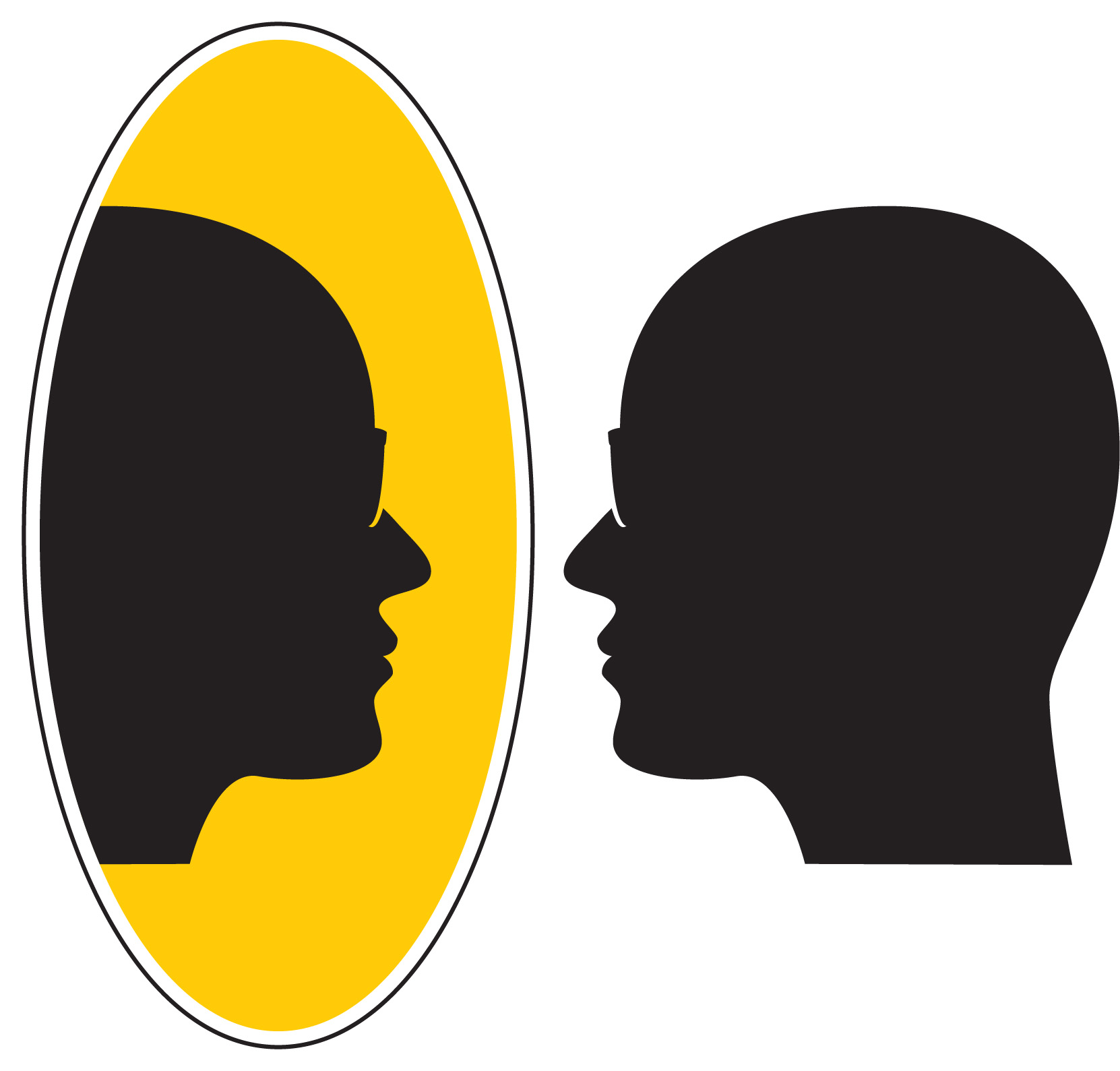
You may imagine that every university campus has one – although we are normally far too busy to see it.
If we should, however, stop and take a look at this mirror, we would see in it the same world that we see around us. But we would also see ourselves in the mirror.
And we would see ourselves in the world.
Seeing ourselves in the mirror
Our theme here is a thorough change of the academic self-conception, which naturally leads to a thorough change of academic values, and ethos.
Seeing ourselves in the mirror symbolizes that we've understood and internalized the fact that we are not those "objective observers" we believed we were – hovering above the world, looking at it through an objective prism of "scientific method", and seeing it as it truly is.
In the excerpt that follows, Einstein will tell us that the scientific concepts and theories are our i.e. human creation. And that there is simply no way to assert that our theories correspond to the real thing.
Physical concepts are free creations of the human mind, and are not, however it may seem, uniquely determined by the external world. In our endeavor to understand reality we are somewhat like a man trying to understand the mechanism of a closed watch. He sees the face and the moving hands, even hears its ticking, but he has no way of opening the case. If he is ingenious he may form some picture of a mechanism which could be responsible for all the things he observes, but he may never be quite sure his picture is the only one which could explain his observations. He will never be able to compare his picture with the real mechanism and he cannot even imagine the possibility or the meaning of such a comparison.
The following excerpt will confirm that our age-old supposition that our ideas and conceptions of the world correspond to reality is a product of illusion.
During philosophy’s childhood it was rather generally believed that it is possible to find everything which can be known by means of mere reflection. (...) Someone, indeed, might even raise the question whether, without something of this illusion, anything really great can be achieved in the realm of philosophical thought – but we do not wish to ask this question. This more aristocratic illusion concerning the unlimited penetrative power of thought has as its counterpart the more plebeian illusion of naïve realism, according to which things “are” as they are perceived by us through our senses. This illusion dominates the daily life of men and animals; it is also the point of departure in all the sciences, especially of the natural sciences.
But if the purpose of our pursuit of knowledge is to distinguish reality from illusion – how can we base it on a criterion (correspondence with reality) that is impossible to verify? And which is itself a product of illusion?
Seeing ourselves in the world
So what is really the purpose of our (academic) pursuit of knowledge?
Or perhaps better said – what should our purpose be?
The space in front of the mirror is the space for academic self-reflection – in which the above and other similar questions are constructively considered.
But seeing the world in the mirror and ourselves in that world has also another effect. The world we see is a world with an urgent need. Seeing ourselves in that world is bound to make us feel responsible.
And so we realize that this self-reflection – however interesting and necessary it might be – is not and cannot be an end in itself, but only a beginning.
Stepping through the mirror
This metaphorical act, of stepping through the mirror, points to a surprising, nearly magical resolution to our quest for self-identity and purpose in front of the mirror.
And as the case is in Lewis Carrol's story, by taking this step, we find ourselves in an academic reality that in many important ways looks like an inverse image of the reality we've grown accustomed to.
What makes this apparent violation of physical laws academically possible is what Villard Van Orman Quine called truth by convention.
If that is how the sciences progress – why not allow our knowledge and knowledge work at large to progress in the same way?The less a science has advanced, the more its terminology tends to rest on an uncritical assumption of mutual understanding. With increase of rigor this basis is replaced piecemeal by the introduction of definitions. The interrelationships recruited for these definitions gain the status of analytic principles; what was once regarded as a theory about the world becomes reconstrued as a convention of language. Thus it is that some flow from the theoretical to the conventional is an adjunct of progress in the logical foundations of any science.
Truth becomes rigorous</p>
Truth by convention is the kind of truth that is common in mathematics: "Let x be... Then..." It is meaningless to ask whether x "really is" as stated.
What makes the magic academically possible is that the truth on the other side is (by convention) the truth by convention. We call this basic convention a methodology.
It stands to reason that our foundation for creating truth and meaning must itself be as solid as possible.
The foundations we've just outlined can be – and have been – made solid in three independent ways:
- They are a convention – and what's asserted in this way is true by definition, irrespective of what happens "in reality"
- This convention express the state-of-the-art epistemological findings, and the insights of giants
- The convention – called methodology – is conceived as a prototype; it has provisions for updating itself, when relevant new insights are reached
<h3>Knowledge becomes useful
On the other side of the mirror we can assign a purpose to knowledge, and to our work, by stating it as a convention.
Notice that this convention is not making any claim to reality, or universality. Someone else can make another convention – and give knowledge a different purpose.
We, however, give our work the purpose you've already seen on our front page – where we discussed the design epistemology. By this convention, knowledge is conceived of and handled as a building block in larger essential systems – our civilization, society, democracy... And it is created, evaluated and used accordingly.
By creating an epistemology by convention, we both liberate knowledge and knowledge work from its age-old subservience to "reality" (and therewith also with the age-old traditional procedures and methods which, as it has been assumed, secured that knowledge would correspond with reality) – and by the same sleight of hand assign it another purpose, such as the purpose of helping people orient themselves in the complex reality.
By combining truth by convention with the creation of a methodology (which is an organized system of fundamental conventions), knowledge work becomes solidly established on the academic ground that Herbert Simon called "the sciences of the artificial" – which do not study what objectively exists in the natural world, but man-made things, with the goal of adapting them to the purposes they serve in the human world.
Our prototype methodology – by which this reversal is made concrete, or even possible – is called Polyscopic Modeling. What we call polyscopy is the praxis this methodology fosters. Usually, however, we simply refer to both simply as polyscopy.
Liberating knowledge
Creating the way we look at the world
Now that the purpose has been successfully reversed, on the academic space on the other side of the mirror we can reverse other facets of our knowledge and knowledge work to serve the new purpose. The first thing that comes to mind is the language and the method.
Our theme – or better said our reversal here is (of) the way in which our concepts are methods, and even information itself, are conceived of, created and used. We are about to witness a reversal of the way in which we look at the world.
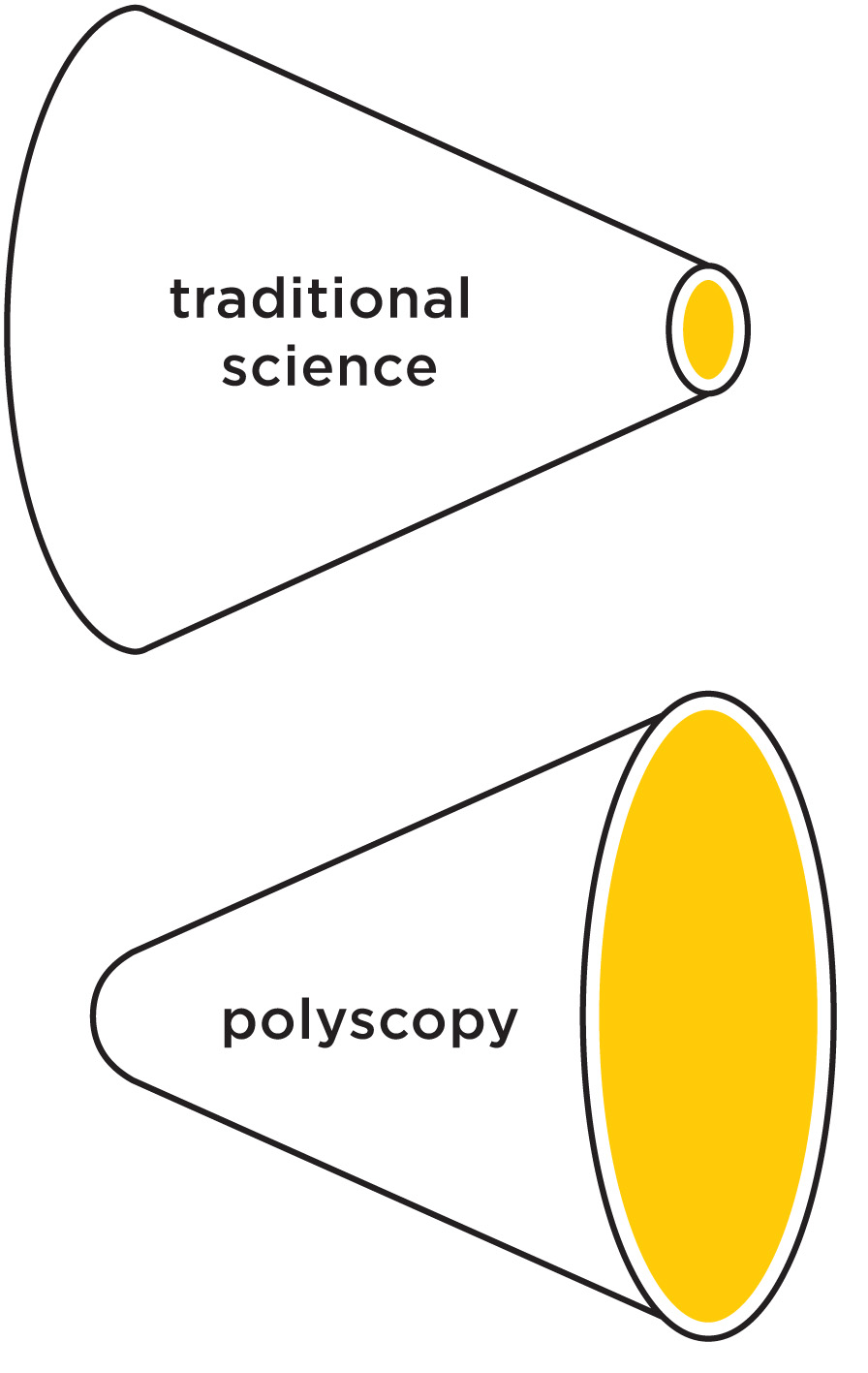
Once we've realized that our concepts and methods are our or more precisely human creations, it becomes natural to recreate them freely – so that we may see more, and see what needs to be seen.
Central in polyscopy is the notion of scope – which is, by definition, whatever determines how we look at the world and how we see it.
Not only our concepts and methods, but also our very models, or "pieces of information", are considered (by convention) to be just that – just ways of looking.
The Polyscopy ideogram stands for the fact that at the point where we've come to see our scopes as our own creation and not our discovery, it becomes natural to adapt them to the purpose of seeing what above all needs to be seen.
From the pen of our giant
Science is the attempt to make the chaotic diversity of our sense-experience correspond to a logically uniform system of thought.
This, and the next quotation of our chosen giant, will give us a clue how exactly we may use this approach to liberate our view of the world from disciplinary and terminological constraints.
I shall not hesitate to state here in a few sentences my epistemological credo. I see on the one side the totality of sense experiences and, on the other, the totality of the concepts and propositions that are laid down in books. (…) The system of concepts is a creation of man, together with the rules of syntax, which constitute the structure of the conceptual system. (…) All concepts, even those closest to experience, are from the point of view of logic freely chosen posits, just as is the concept of causality, which was the point of departure for this inquiry in the first place.
This is how Einstein stated his "epistemological credo" on the introductory pages of his Autobiographical Notes. Already the fact that a scientist should begin his personal account of the development of modern physics by stating an "epistemological credo" is significant – Isn't that exactly what we are doing here, on this page?
You'll notice that there is no mention of "reality" in the above excerpts; only "the sense-experience" on the one side, and "the system of concepts" and "syntax" or method on the other. This latter part, posits Einstein, is "freely chosen", and even "the concept of causality" is freely chosen – which was the point of departure of traditional science (which has been conceived as an attempt to explain how the observed phenomena follow as a consequence of the inner workings of nature).
Simplicity and clarity are in the eyes of the beholder
As might be expected, polyscopy turns Einstein's "epistemological credo" into a convention.
Combined with the epistemology sketched above, this translates into an approach to knowledge where we design concepts and methods – by adapting them to the purpose, what needs to be seen.
And where the conventional scientific approach to establishing and justifying facts is liberated from disciplinary constraints and made completely general.
By convention, experience (or "reality") is not assumed to have any a priori structure. Rather, what is "out there" is considered as something like the inkblot in the Rorschach test – namely as something to which we assign meaning; and to which a multiplicity of meanings can be assigned (notably by creating suitable ways of looking or scopes).
The "aha experience" – that the provided scope fits or interprets or explains experience – is then also considered as just another kind of experience, which can be communicated from the author to the reader.
The "aha experiences" are especially valuable when they are shared – when they can orient our collective action. But they can also be dangerous, because we can keep us in one way of looking at things, and ignoring all others – at the expense of further creative exploration, and communication. Polyscopy emphasizes that there are multiple ways of looking and multiple ways of making sense, and that an inner and a social dialog – fine balance between grasping an offered interpretation and remaining open to other interpretations – is maintained.
Since scopes are human-made by convention, they can be as precise and rigorous as we desire – on any level of generality.
Simplicity and clarity, by convention, are "in the eyes of the beholder" – (a consequence of our scope). Hence we can freely and legitimately create them – even in a complex world!
Models are scopes
An interesting "philosophical" question is – What do we really mean when we make a statement, that something is so-and-so, if we are not claiming that this is how the reality "really is"?
The answer provided by polyscopy is that our statements, and models, are (by convention) just scopes, just our own created ways of looking at experience and of organizing experience. They are a way of saying "See if you can see things (also) in this way, and if this way of looking may reveal to you something that you may otherwise have overlooked."
As Piaget wrote, "Intelligence organizes the world by organizing itself"
Multiple scopes are needed
Think about inspecting a cup you are holding in your hand, to see if it's whole or cracked. You must look at it from all sides, before you can give a conclusive answer. And if any of those points of view reveals a crack – then the cup is cracked!
In polyscopy's technical language we say that to acquire a correct gestalt, all relevant aspects need to be considered.
No experiences are automatically excluded
Another consequence of this approach to knowledge is that no experience is excluded because it fails to fit into our "reality picture".
On the contrary – since the substance of information, and of knowledge, is ultimately human experience, then all forms of experience are considered to be potentially valuable. The method sketched here allows for combining a variety of heterogeneous insights and forms of experience to create a high-level view. Examples of this are shared below.
General-purpose science
The overall result is a general-purpose method which – like a portable flashlight – can be pointed at any phenomenon or issue.
The objective of studies needs to be to direct the mind so that it brings solid and true judgments about everything that presents itself to it.
René Descartes is often "credited" as the philosophical father of the limiting (reductionistic) aspects of science. This Rule 1 from his manuscript "Rules for the Direction of the Mind" (unfinished during his lifetime and published posthumously) shows that also Descartes might have preferred to be remembered as a supporter of polyscopy.
Growing knowledge upward
Science on a crossroads

The Science on a Crossroads ideogram points to the possibility to reverse the narrow and technical focus in the sciences – and create general insights and principles about any theme that matters. In the explanation of this ideogram we outline a method by which this can be achieved.
The Science on a Crossroads ideogram depicts the point in the evolution of science when it was understood that the Newton's concepts and "laws" were not parts of the nature's inner machinery, which Newton discovered – but his own creation, and an approximation. Two directions of growth opened up to science – downward, and upward. The sequence of scientists "converging to zero" in the ideogram suggests that only the "downward" option was followed.
The moment when this happened
It has turned out that the very moment when science reached those crossroads has been recorded!
In his "Autobiographical Notes", after describing how the successes of science that resulted from Newton's classical results led to a wide-spread belief that there wasn't really much more than that, as we saw above, Einstein discusses on a couple of pages the anomalies, results of experiments and observed phenomena that were not amenable to such explanation. He then concludes:
Enough of this. Newton, forgive me; you found just about the only way possible in your age for a man of highest reasoning and creative power. The concepts that you created are even today still guiding our thinking in physics, although we now know that they will have to be replaced by others further removed from the sphere of immediate experience, if we aim at a profounder understanding of relationships.
Why the direction "up" was ignored
The direction "up" is a natural direction for the growth of anything – and of knowledge in particular. Hans't the insight, the wisdom, the general principle, always been the very hallmark of knowledge? So why did science continue its growth only downward – toward more technical, more precise – and more obscure results?
The reason is obvious, and it is also suggested by Einstein: It had to be done, "if we aim at a profounder understanding of relationships" – that is, of natural phenomena. They turned out to be far more complex than it was originally believed.
The bottom-level reality picture turned out to be retreating ever deeper – as the scientists aimed "at a profounder understanding of relationships".
So why not do as Newton did in all walks of life i.e. wherever solid knowledge is needed – create approximate models that serve us well enough?
The answer is obvious. The disciplinary organization of knowledge had already taken shape. Einstein being "a physicist", his job was to study the physical phenomena, in terms of the masses and velocities and mathematical formulas.
The job of updating the whole production of knowledge – and the job of creating high-level insights – happened to be in nobody's job description. And hence they remained undone.
By giving those two lines of work a name, knowledge federation, we undertake to call them into existence.
Guided evolution of knowledge
The evolution of knowledge is further directed by defining the criteria, what knowledge needs to be like. The polyscopy definition includes four criteria, which are substituted for "the correspondence with reality".
By convention, having a correct gestalt is what "being informed" is all about. You may know the exact temperature i every room, and even the CO2 percentages in the air. But it is only when you know that your house is on fire that you know that you need to evacuate the house and call the fire brigade.
Knowledge federation in two pictures
Information

The Information ideogram points to the structure of the information that knowledge federation aims to produce. Or metaphorically, our theme here is the construction of a suitable 'light bulb', and the nature its 'light'. In the explanation of this ideogram it is shown how the methodological ideas just described support this construction. Or more to the point, and metaphorically – this ideogram shows how to create information that is structured (or 'three-dimensional'), not 'flat'.
The “i” in this image (which stands for "information") is composed of a circle on top of a square. The square stands for the technical and detailed low-level information. The square also stands for examining a theme or an issue from all sides. The circle stands for the general and immediately accessible high-level information. This ideogram posits that information must have both. And in particular that without the former, without the 'dot on the i', the information is incomplete and ultimately pointless.
This ideogram also suggests how to create high-level views based on low-level ones. And to justify high-level claims based on low-level ones – by 'rounding off' or 'cutting corners'.
Knowledge
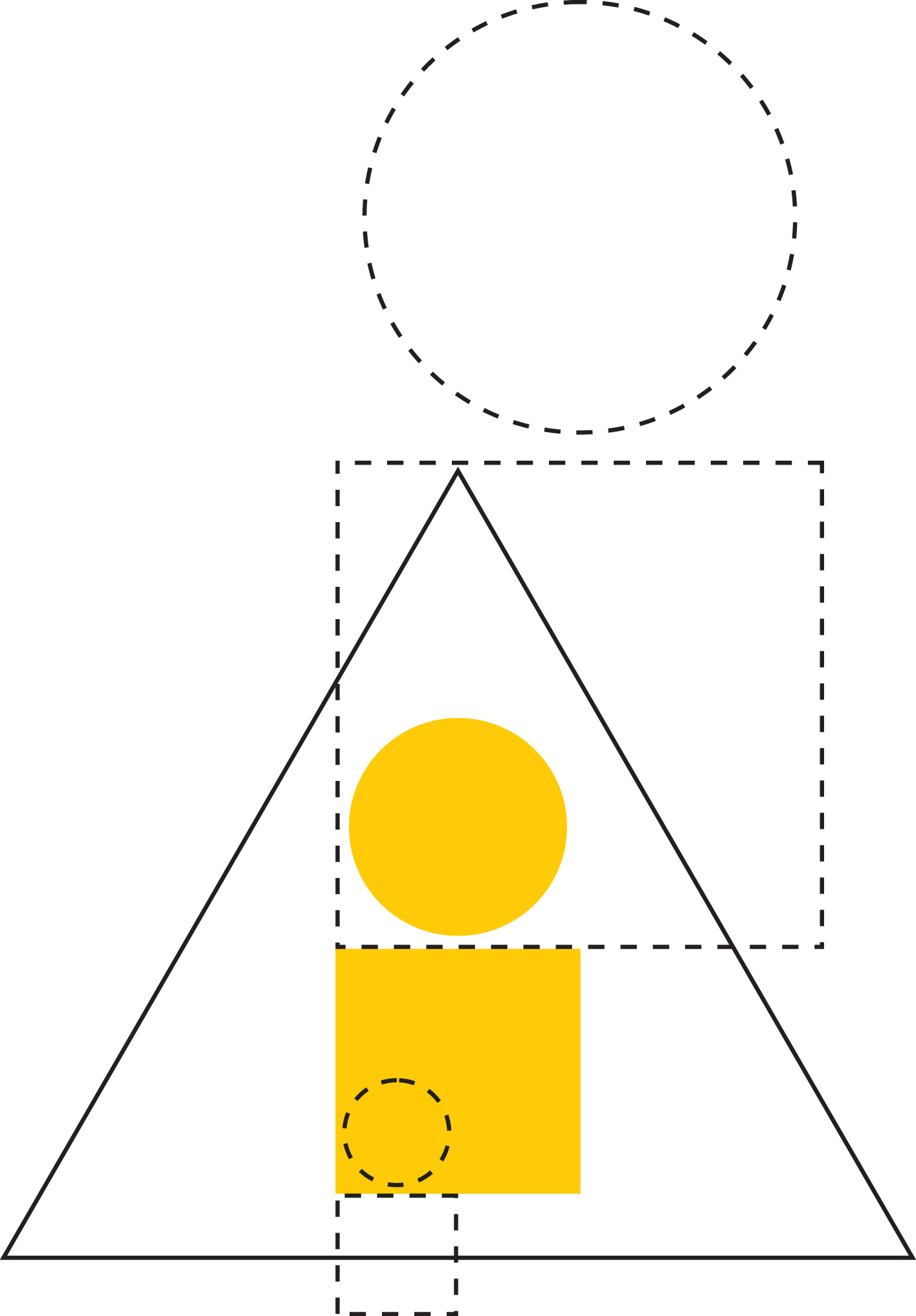
The Knowledge ideogram depicts knowledge federation as a process – and also the kind of knowledge that this process aims to produce.
It follows from the fundamentals we've just outlined that (when our goal is to inform the people) knowledge federation will do its best to federate knowledge according to relevance – and adapt its choice of scope to that task. The rationale is that "the best available" knowledge will generally be better than no knowledge at all. Knowledge, and information, are envisioned to exist as a holarchy – where the low-level "pieces of information" or holons serve as side views for creating high-level insights. Multiple and even contradictory views on any theme are allowed to co-exist. A core function of federation as a process is to continuously negotiate and re-evaluate the relevance and the credibility of those views.
Two examples
Power structure
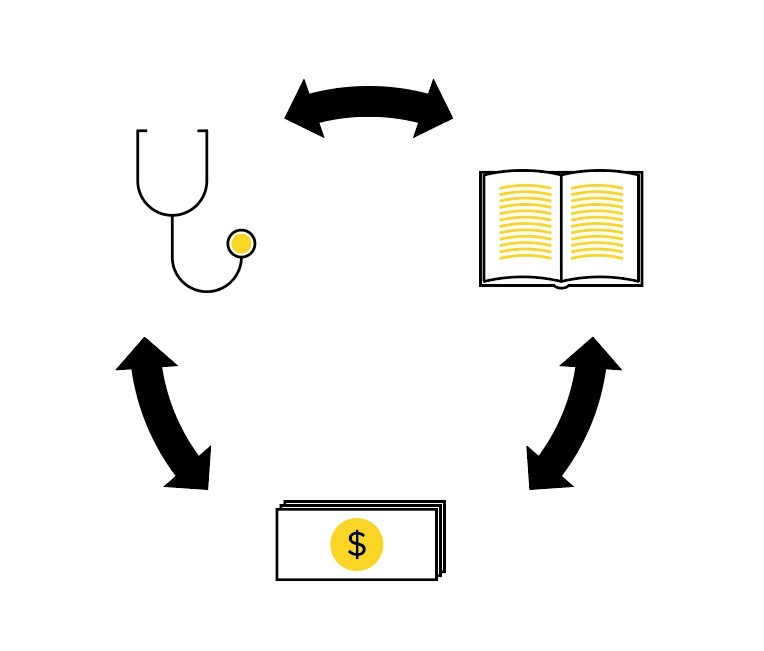
As a way of looking at the world or scope, the power structure empowers us to conceive of the traditional notions of "power holder" and "political enemy" in an entirely new way – and to reorient our ethical sensibilities and our political action accordingly.
The Power Structure ideogram depicts the power structure as a structure, where seemingly distinct and independent entities such as monetary or power interests, the ideas we have about the world, and our own condition or health are tied together with subtle links, so that they evolve and function in co-dependence and synchrony.
In "A Century of Camps", from which we've quoted the above paragraph, Zygmunt Bauman explained how even massive and unthinkable cruelty (of which the Holocaust is an example) can happen as a result of no more than (what we are calling) the structure of the system – and people just "doing their jobs".
The power structure model explains in what way exactly malignant societal structures can evolve by the conventional "survival of the fittest".
To legitimize the view in which a complex structure (and not a person or group endowed with intelligence and identifiable interests) is considered "the enemy", insights from a range of technical fields including combinatorial optimization, artificial intelligence and artificial life are combined with insights from the humanities – including Bauman's just quoted one.
An effect of this model (central to the paradigm strategy we are presenting as our larger motivating vision) is that it entirely changes the nature of the political game, from "us against them" to "all of us against the power structure".
By revealing the subtle links between our ideas about the world and power interests, the power structure helps us understand further why a new phase of evolution of democracy, marked by liberation and conscious creation of the ways in which we look at the world, is a necessary part of our liberation from renegade and misdirected power.
Convenience paradox
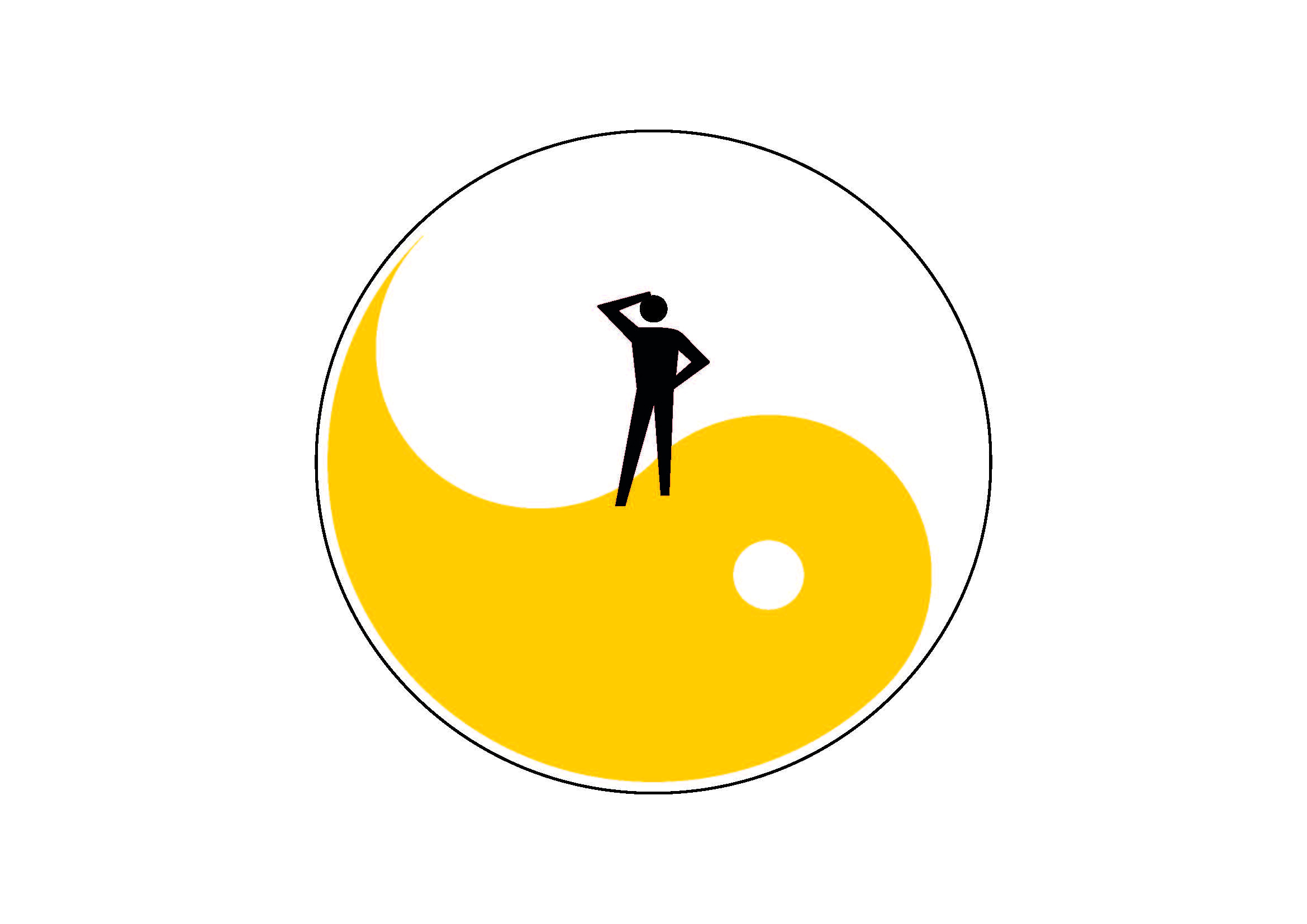
Redirecting our "pursuit of happiness" is of course a natural way to give a new direction to our 'bus'. Informing our "pursuit of happiness" is also a natural application where the ideas presented above can be put to test.
The Convenience Paradox ideogram depicts a situation where the pursuit of a more convenient direction (down) leads to an increasingly less convenient condition. The human figure in the ideogram is deciding which way to go. He wants his way (of life) to be more easy and pleasant, or more convenient. If he follows the direction that seems more convenient, he will end up in a less convenient condition – and vice versa.
By representing the way to happiness as yin (which stands for dark, or obscure) in the traditional yin-yang ideogram, it is suggested that the way to convenience or happiness must be illuminated by suitable information.
This ideogram is of course only the high-level part, the circle or the 'dot on the i'. Its low-level part or justification consists of a variety of insights emanating from a broad variety of giants and traditions. The rationale is to select the ones that resulted from the experience of working with large numbers of people – and which have something important to tell us about our civilized condition; and about ways in which this condition could be radically improved.
An example is the above core insight of F. M. Alexander, the founder of a therapy school called "Alexander Technique", which is now being taught worldwide.The process of civilization, according to Alexander, has contaminated man’s biological and sensory equipment, with a resultant crippling in the responses of the whole organism. Tension and conflict are more and more substituted for coordination.
A more spectacular examples are from various Oriental traditions who pointed to the nature of "the way" (to happiness or fulfillment, represented by the dark Yin part of the ideogram), while calling it different names such as "Tao" or "Do" or "Yoga" or "Dharma" or "Tariqat". Taken together, they enable us to model the most interesting range of possibilities we are calling "happiness between one and plus infinity" – which is a direction in which our civilization's "progress" may most naturally continue.
We'll say more about both of these themes, and how they are related, in Federation through Conversations – where we'll also initiate a conversation to collectively refine them and develop them further.


